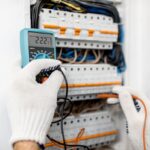Electricity is the invisible backbone of our daily routines—from powering the coffee machine to keeping the city lights on after dark. Yet most of us treat it as a black‑box marvel that simply works. Understanding the fundamentals of electrical systems not only keeps you safe but also helps you make smarter choices when upgrading, repairing, or installing new appliances.
1. The Basics of Current, Voltage, and Resistance
At its core, electricity is the flow of electrons through a conductor.
- Current (measured in amperes) is the amount of charge passing through a point each second.
- Voltage (volts) is the potential energy that pushes electrons along the circuit.
- Resistance (ohms) is the opposition to flow, determined by the material and dimensions of the conductor.
The relationship between these three elements is given by Ohm’s Law: V = I × R. A simple way to remember this is the “voltage‑current‑resistance” triangle—change one, and the others adjust accordingly.
2. Wiring, Circuits, and Breakers
Residential homes typically use a 240‑volt supply split into two 120‑volt legs. Distribution is managed by a panelboard that houses circuit breakers—protective devices that trip when a circuit is overloaded. Modern homes also include dedicated circuits for high‑power appliances such as ovens, HVAC units, and electric vehicles.
When installing or modifying wiring, it’s essential to follow the National Electrical Code (NEC). Violations can lead to fire hazards, equipment damage, or costly code‑compliance work.
3. Safety First: Common Electrical Hazards
- Overloaded outlets: Plugging too many devices into a single outlet can cause overheating.
- Damaged cords: Frayed insulation exposes live wires, increasing shock risk.
- Water and electricity: Even a slight moisture presence can create dangerous pathways for current.
If you notice any of these issues, consult a licensed electrician immediately. Professional inspections help catch hidden problems before they become emergencies.
4. When to Call a Professional
Routine maintenance isn’t just a good idea—it’s a necessity. Homeowners should schedule a periodic review of their electrical system, especially after renovations or the addition of new appliances. For those planning a major remodel, a pre‑construction inspection can uncover potential code violations early on.
If you’re looking for expert guidance, a trusted resource is a certified electrical inspection service. Certified inspectors have the training to evaluate your system comprehensively, from panelboards to grounding, ensuring compliance with the latest NEC updates.
5. Energy Efficiency and Smart Tech
Modern electrical upgrades can dramatically cut energy consumption.
- LED lighting uses up to 75% less energy than incandescent bulbs.
- Smart thermostats adjust heating and cooling based on occupancy patterns.
- Dedicated circuits for HVAC units reduce the load on general-purpose breakers, improving overall system reliability.
6. Takeaway
Electricity powers everything we cherish, yet its proper management is often overlooked. By grasping the basics, respecting safety protocols, and engaging qualified professionals—especially for certified electrical inspections—you can protect your home, save money, and ensure that the flow of electrons keeps life humming smoothly.















Leave a comment